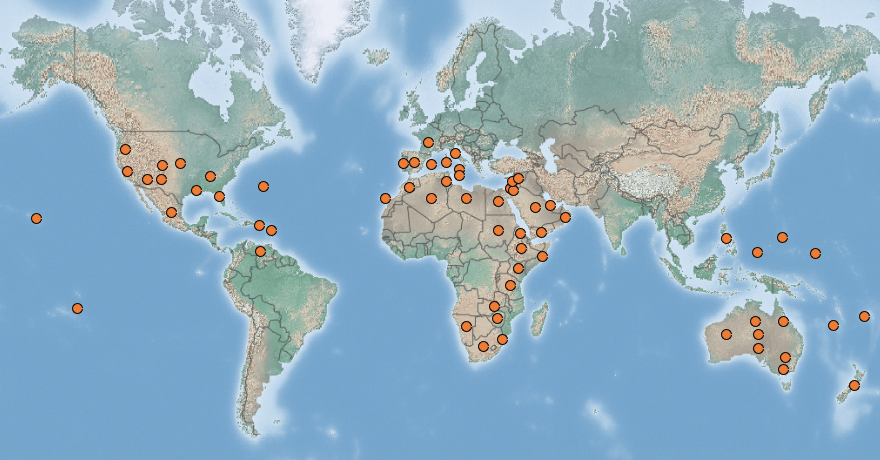 |
Crimson fountaingrass | Status LU: introduced. 1st record: LU 2019, ITW n/a. |
 |
Buuschtegt Lanterbotzergras | Status Eur.: established. 1st record: unkn. IAS of EU concern (2017). |
 |
n/a | RA: ISEIA: C1. Harmonia+: n/a |
 |
Afrikanisches Lampenputzergras | Wikipedia: |
 |
n/a | Back to the list of neophytes |
Contents
Report the species
→ Report Pennisetum setaceum to the National Museum of Natural History.
Brief description

Pennisetum setaceum on Kahoolawe Island (Hawai)
Pennisetum setaceum (Forssk.) Chiov., commonly known as crimson fountaingrass, is a C4 perennial bunch grass that is native to open, scrubby habitats in East Africa, tropical Africa, the Middle East and SW Asia. It has been introduced to many parts of the world as an ornamental plant, and has become an invasive species in some of them. It is drought-tolerant, grows fast, reaches 3 feet in height, and has many purple, plumose flower spikes. Fountaingrass has been introduced to the Canary Islands, Sicily, Sardinia, southern Spain, Australia, South Africa, Hawaii, the Western United States, California, southern Florida and New Caledonia. It thrives in warmer, drier areas and threatens many native species, with which it competes very effectively as an invasive species. It also tends to increase the risk of intense wildfires, to which it is well adapted, thus posing a further threat to certain native species (Wikipedia contributors 2019).
IAS of Union concern
In 2017, Pennisetum setaceum (Forssk.) Chiov. was added to the list of invasive alien species of Union concern (Anonymous 2017) which implies that member states shall take all necessary steps to prevent its unintentional introduction or spread.
Status and distribution in Luxembourg
Records of Pennisetum setaceum (Forssk.) Chiov. in Luxembourg. Data source: Recorder-Lux, iNaturalist & GBIF, 2025-12-09.
Risk assessment
ISEIA protocol
C1 (3+2+2+1). First assessed 2021-02-16 by C. Ries & Y. Krippel.
Harmonia+ protocol
Not assesed yet.
Worldwide distribution
Bibliography
- Anonymous, 2017. Commission implementing regulation (EU) 2017/1263 of 12 July 2017 updating the list of invasive alien species of Union concern established by Implementing Regulation (EU) 2016/1141 pursuant to Regulation (EU) No 1143/2014 of the European Parliament and of the Council. Official Journal of the European Union L 182: 37-39 (13.7.2017).
- CABI, 2010. Pennisetum setaceum. In: Invasive Species Compendium. Wallingford, UK: CAB International. URL: www.cabi.org/isc [accessed 2020-03-04]
- MNHNL, iNaturalist & GBIF, 2020. Pennisetum setaceumin MNHNL-mdata, online portal combining species observation from Recorder-Lux, iNaturalist and GBIF. National Museum of Natural History, Luxembourg. URL: https://mdata.mnhn.lu [Accessed 2020-03-04]
- Ries, C. & Y. Krippel, 2021. First records of 56 invasive alien vascular plants in Luxembourg. Bulletin de la Société des naturalistes luxembourgeois 123: 115-127. [PDF 241 KB]
- Signoret, S., 2020. Inventaire d’espèces exotiques envahissantes dans des arboretums, jardins botaniques et parcs aménagés au Luxembourg. Étude réalisée pour l’Administration de la nature et des forêts, 57 p. [PDF 6MB]
- Wikipedia contributors, 2019. ‘Pennisetum setaceum’, Wikipedia, The Free Encyclopedia, 27 September 2019, 08:25 UTC, <https://en.wikipedia.org/w/index.php?title=Pennisetum_setaceum&oldid=918152552> [accessed 2020-03-04]
Suggested citation of this webpage
Ries, C., M. Pfeiffenschneider & Y. Krippel (Eds.), 2025. Pennisetum setaceum (Forssk.) Chiov. In: neobiota.lu - Invasive Alien Species in Luxembourg. National Museum of Natural History, Luxembourg. URL: https://neobiota.lu/pennisetum-setaceum/ [Accessed 2025-12-09].
Page content last updated on 2025-08-10. Last proofread by Caroline Grounds on 2020-03-05.


